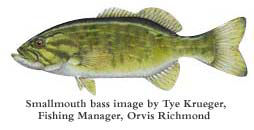
Smallmouth bass fishing in lakes during midsummer is usually a dawn and dusk commando operation. During the day, they stay in water 10 to 30 feet deep, and although you can catch them on a sinking line it’s a lot of work. However, in rivers, smallmouths are active all day long, even in the heat of summer. So your best bet for summer smallmouth fishing is to find a river with a rocky bottom, clear water and midday water temperatures that stay below 75 degrees.
In lakes, look for smallmouths early and late in the day at the edges of drop-offs, along rock cliffs, and where the shoreline is cluttered with boulders or fallen logs. In rivers they can be almost anywhere except in very fast current, but they’ll often lie in the eddies adjacent to fast water. One of my favorite places for big smallmouths in rivers is in the tail end of a pool where the water gets broad and shallow. This water might not look fishy to you, but it’s one of the best places for smallmouths to prowl for crayfish and baitfish, their favorite foods.
How to catch smallmouths
One of the reasons I love smallmouth bass is that they are usually eager to take a fly on the surface. Some fly fishers swear that a slider with a cone-shaped head like the Sneaky Pete is the only fly you need. In moving water, cast your popper just above where you think a bass may be hiding and let it drift downstream with an occasional twitch to catch their interest. Even if you find smallmouths rising to hatching insects like mayflies, you can match the hatch if you want, but I’ve found that even when feeding on insects smallmouths will jump on a Sneaky Pete (which looks nothing like any mayfly) just as easily.
In slower pools on in lakes, you can’t move your fly too slowly. Cast and let the fly sit still, until all the rings dissipate. Wait. Wait longer. Wait until you can’t stand it. Smallmouths will often eyeball a fly for over a minute before suddenly pouncing on it. If nothing takes your motionless fly, try a few small twitches with a long rest in between. But if that doesn’t work, try a faster retrieve or even a steady retrieve with no pauses. You never know what might turn them on.
Because smallmouths love crayfish and baitfish, streamer flies are often more productive. The standard streamer retrieve where you strip six inches at a time often works, but you’ll catch more smallmouths if you slow down. A strip followed by a long pause is very effective, especially with a weighted fly, because smallmouths seem to prefer taking a fly as it is dropping. Just watch your floating line and if it jumps forward or hesitates set the hook. Streamers or even large nymphs are also deadly on a dead drift in the current, without adding any action other than what the current imparts. Many of the best smallmouth anglers I know fish for smallmouths much as you do for trout, under a strike indicator. I’ve had too many smallmouths eat my strike indicator, though, so I like to use a popper as an indicator. Just tie a Sneaky Pete to a 9-foot 2X leader, tie 20 inches of 3X tippet to the bend of the popper hook, and tie a big nymph or streamer on the end of this tippet.
Tom's Fly Picks for Smallmouth Bass

Just the finest smallmouth fly ever made. It’s been a favorite for over 30 years. The cone-shaped head and rubber legs make just enough commotion to attract smallmouths but not enough noise to scare them. Plus it casts easier than a standard popper.
Peeper Popper
There are times when a noisy popper works better for smallmouths, especially in big, deep rivers or where the water is slightly murky.
Gulley's Crawfish
This crawfish is about as realistic as you'll ever see and bass do love crawfish. Fish it slow on the bottom.
EZ Mite
Smallmouth bass also eat a lot of hellgrammites, so this buggy imitation of these large insect larvae turns them on, especially in rivers.
Rattle Eye Minnow
One of the best fly fishers I know swears by the Rattle Eye Minnow, which darts like a Clouser Minnow but also has tiny glass rattles as eyes. The tiny clicking sound really bangs the dinner bell for smallmouths, especially in deep or slightly dirty water.
Cone Head Woolly Bugger
The Woolly Bugger simulates a crayfish, hellgrammite, large stonefly, sculpin, or a leech. The cone head gets it down quickly and makes it hop and dart in the water, an irresistible action for smallmouths.




